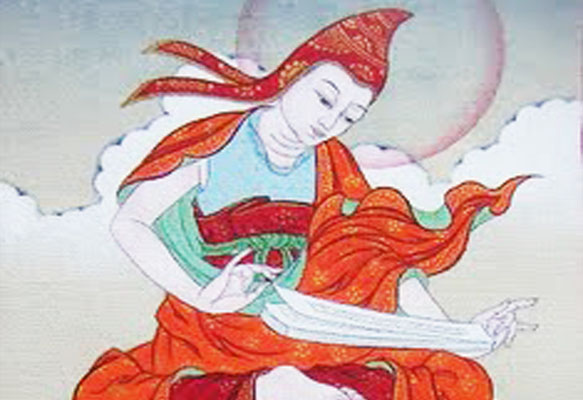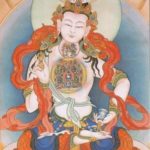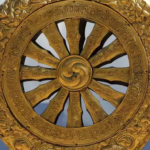Realizing the true source of Joy
The Power of Mind in Buddhist Thought
By Pema Khandro
“Mind is the seed of the world’s joy and the remedy for it’s suffering.” – Shantideva
Buddhist philosophy centers on the power of mind. Our perceptual habits can imprison us. Yet, when the nature of mind is understood, then our perceptions can also liberate us.
We cannot always change circumstances, but we can always change our minds. (One of the most dramatic examples of this is the story of Gelongma Palmo). Therefore, because we can also change our mind, freedom of mind is our fundamental freedom, one that many people deprive themselves of by leaving mind as an untapped resource, or by leaving it as an untamed, unconscious force.
Mental habits may sometimes make changes seem impossible. Mental habits are both conscious and unconscious. Buddhism examined the unconscious mind two thousand years before Freud and Jung came up with their theories of the unconscious – but all agree – that unconscious mind can be a powerful and driving influence in our lives.
In Tibetan Buddhism, the subconscious mind is not just negative, we also have a deeper layer that we are unconscious of – one that is naturally good. Buddhist practices and philosophy are all used to awaken this deeper potential of mind – deeper than what we think of as the subconscious. Deeper than our subconscious mind, our karmic scripts, our social programming and even deeper than the undigested emotions from traumatic events, there is an underlying, self-existent wakefulness, which is good and clear. It is fresh and whole. This is what is known as buddha-nature.
Emptying out Misconceptions
To access that deeper sense of spaciousness and freedom, we can begin by dissolving our habitual rigidity. Buddhism begins the path by addressing the long developed habit of concretizing our problems and reifying our finite identity. In Tibetan language this is described as no-zin – དངོས་འཛིན། – the tendency towards concretizing reality, or investing in illusions as if they are real. We can break through this tendency to concretize, by attuning to the open-ended quality that is always present – emptiness itself.
This key feature of the Buddhist theories of experience is the notion of “emptiness.” Emptiness is an open-ended quality to experience. This is a highly sophisticated concept that has different meanings depending on the various Buddhist vehicles. (See Pema Khandro’s previous article on emptiness). In its most basic and general meaning, the theory of emptiness points to things being other than they seem. Things may appear one way, but ultimately there is more to the story. Our mind and its world is less solid, definite and continuous than we think. This openness of reality can be discovered experientially. Its one of the first things we discover in meditation.
Through Buddhist practices we seek to see how mind works and to know more about what it is to be a human being. We seek to recognize mind’s interpretations, habits and underlying nature. We discover that most of the time- we are relating to our interpretations of reality, rather than relating reality itself. This may initially be a disappointment but it is ultimately empowering – because reality itself is more open-ended than we think – therefore it is more workable than we think.
The problem of un-enlightenment is the problem of unconsciously interpreting reality in terms of habitual tendencies. The goal of Buddhism is to wake up to how our minds work, so we are no longer bound by our interpretations and so that we are no longer mistaking them for realities.
Emptiness is a profound concept. It takes time to get to its meaning, maybe a lifetime. It refers to all concepts being only partial representations of reality. It refers to impermanence. It refers to interdependence, that things are empty of independant existence and instead always exist in a contingent way – dependently originating based on many other factors. Its ultimate implications are profound, but experimenting with the view of emptiness yields a tangible experience – a pliability to mind – and therefore the room to enjoy a more spacious experience.
On a practical level, I teach two slogans for helping to attune to this emptiness as the openness of reality. These are interesting practices for how to tap in a sense of emptiness. The first slogan is, “Maybe that’s true.” This is something we can say to ourselves whenever we find ourselves fixed or tense. It makes some room for what we are experiencing and the possibility of more. The key to evolving is to see beyond our current perspective. “Maybe that’s true,” makes room to move in new directions.
The second slogan is, “Its Me.” This is the most empowering slogan – to repeat many hundreds of thousands of times – to realize our state of being is in our hands. No one else is to blame for it and no one else can save us or change it. We have this extraordinary power of mind. In Tibetan language they say the mind is yi shin norbu – like a wish-fulfilling jewel. Once we acknowledge the power of mind we can begin to explore its boundless capacity to fulfill our wish for peace and to remedy the true source of our suffering.
Of course, in terms of circumstances, it is not always “me,” when dealing with psychopaths, sociopaths, narcissists and abusers. In that case – it is harmful to ourselves and to them when we internalize blame for their tensions. It is harmful to others to enable their neurosis. However in this case, the slogan, “Its me,” could still be useful as a place to begin because we have to ask ourselves why we are continually putting ourselves in these situations. “Its me” can be a reminder to remove ourselves from unhealthy environments or make positive change in situations that need to be changed. “Its me” can drive us to no longer to wait to be saved, or wait for permission. Transformation is up to us. “Its me,” can be a reminder that no matter how people treat us, our state of being is still up to us.
Its impossible to be happy until we recognize that our own minds are the only true source of happiness. But to find this out, we have to let go of blaming others, and blaming circumstances – we must begin relying on mind, working with mind and digging deep to find our buddha-nature.
Mind & Society
We may wonder, what is the power of mind in a period of social unrest and institutionalized oppression? It is in such times that clear, sane and empowered mind is our most important resource. Without a sense of clarity found in our buddha-mind we are left with knee-jerk reactions, responding to hate with more hate – which only feeds the true problem. Love and understanding are not the antithesis to social action, they are the basis of effective change. We cannot solve problems that we do not understand.
This conviction is what drove me deep into Buddhist thought. My encounters with racism and sexism kept leaving me feeling like the problem was overwhelming. After all, racism is not just about racism, it is interwoven with issues of class, education and economics. Sexism is not just a matter of gender socialization – it also has to do with entrenched habits around power, domination and again – economic structures. Achieving gender equality is not just about changing social structures, but also about addressing the social scripts and internalized oppression that keep reproducing those structures from within our very own minds!
The more we look for answers to these questions, the deeper into the rabbit hole we go – it seems that every problem is much bigger than we realize – and interconnected with all other problems. It could be paralyzing, until we realize that underlying all these problems is the very same underlying fundamental problem – ignorance.
By addressing the most basic issues of human suffering and human ignorance, we make way for the dignity, mutual empowerment and true change that relies on understanding the power of mind.
When we realize that mind is the source of joy and the remedy for suffering, we reaffirm our conviction of the self-existing dignity of every human being. Quite practically, we have the key insight which allows us to develop the room to communicate with others with patience and skill. Following such an insight we must train in choosing actions wisely and cultivate wisdom in our work, family and society. But at the heart of all effective social action, is a vision that first arose from the clarity of wisdom mind.
Does this mean that we should sit around and meditate while our world falls apart? Absolutely not. Those who sit should also take a stand. (1)
What Buddhism advocates for is action with attention to intentions, action with attention to our mindset, action with attentiveness to innate goodness. Of course we can, should and must change our world – and simultaneously we must take seriously the mind which is the source of our experience of that world.
Mind and Body
It is important to remember – the power of mind is not disembodied. For Tibetan Buddhists body and mind exist on a continuum, both expressing the spectrum of being.
This is why Buddhist Yogis rely on breathing practices and visualizations as a two way street, transformation is more accessible if we change mind and body at the same time. By changing the body we can alter the speed of our thoughts, our mood and even our identity. This is why – learning how to meditate begins with correct posture. (See Pema Khandro’s guide for how to meditate).
Do You Find Comfort and Ease in Your Mind?
Shantideva says, “mind is the seed of the world’s joy and the remedy for its suffering.”
Tibetan Buddhism is based on the idea that every person can only find happiness by coming to terms with their own mind. Maybe this seems daunting, because, after all, is your mind a beautiful peaceful place to be? If it is not yet a fresh space, it can be with some training.
Initially, like an overgrown garden that has never been tended, mind may need some caring for. Buddhist philosophy and practice are abundant resources for this. So even if it is daunting at the beginning, as we begin to develop a relationship with our deeper mind – our buddha-mind – we find that underneath all the chaos is something naturally beautiful. We enter a life long journey into the discovery of sanity and goodness. If we can make peace with our minds, learn how to settle it, to clear it, to open it – this is the greatest empowerment there is. Because then we will always have a freedom – a freedom that can never be taken from us – freedom of mind.
We are not left to go on this journey without any sense of assurance, without any maps or tools. Its the beauty of tradition, we are given a vehicle, a system, we are given reliable methods and we are given testimonials from others who have gone on the journey. Their songs of realization are beacons of light for us which demonstrate what is possible. One of my favorite of such prayers is that of Longchenpa. He expresses the sense of wonder and spaciousness found in the nature of mind.
“Homage to glorious Samantabhadra, complete goodness,
to timeless buddhahood, basic total presence,
to unchanging spontaneity, the spacious indestructible-heart,
to the nature of mind – natural perfection,
constantly, simply being, we bow down.”
– Longchenpa
In Buddhist thought, his view – that natural goodness is the true heart of every being is known as “Dzogchen,” (Tib rdzogs chen), which means, ‘the great perfection.’ In every person is a fundamental goodness and wisdom which is whole. By living in tune with this goodness, by acting on this goodness we can discover a sense of natural confidence.
This makes us available to care for others and care for this world. Therefore, delving into mind could also lead to finding the remedy for the world’s suffering. By understanding our own minds, we can understand the cause of suffering and develop a loving, kind relationship with our world. We can also understand why others behave badly – because they are suffering, because they long for happiness. If we don’t know this, we are missing the real truth behind every person we encounter.
Even if we have natural goodness, there is a great deal of confusion and suffering that can still take place. But it comes from being disconnected with our natural state, disassociated from the true power of our wisdom mind.
When we see this confusion and suffering in ourselves, we can begin to transform it and heal by caring for body and mind properly through practices like prayer and meditation. (See Pema Khandro’s guide for how to meditate).
When we see this confusion and suffering in others, we can proceed from understanding where their pain comes from, because we have seen this first hand within our own minds.
– Excerpted from Pema Khandro’s teaching on The Guide to the Bodhisattva’s Way of Life, the Bodhicharyavatara.
_____________________
Footnotes
(1) This saying is not my own – I read it somewhere and loved it.
_____________________
You will find answers to frequently asked questions about practice and study with Pema Khandro here.
Do you feel like health issues block you from finding freedom of mind? You may also benefit from reading Pema Khandro Rinpoche’s article Carrying Illness Onto the Path
Or read a teaching on helping others, from Pema Khandro at Lion’s Roar Magazine: You’re Ready Enough. Sorrow and mourning are not separate from joy, they are part of the whole-hearted experience of buddha-nature. Read Pema Khandro’s article on loss and change.
Want to learn more? Train with Pema Khandro in our new online self-paced courses: Pema Khandro Buddhism Online











